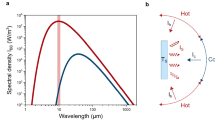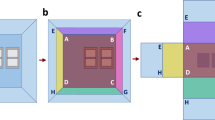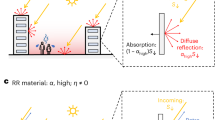Abstract
As climate change accelerates, extreme heat events will intensify, threatening vulnerable populations experiencing dangerous heat outdoors. Active radiant cooling has recently emerged as a promising strategy for outdoor thermal comfort, at it offers cooling at a distance without the inefficiency of conditioning unconfined air. However, for radiant cooling structures to be effective, the overwhelming majority of their internal surfaces must be actively cooled, typically with visibly opaque panels, raising practicality and safety concerns. Here, we demonstrate that thermal comfort can be achieved in an outdoor cooling structure that lightly uses radiant cooling and amplifies this cooling effect using visibly transparent, infrared-reflective surfaces. This approach enables visibly open cooling structures that will be accepted by a wide range of communities. We first derive an analytical model that relates the mean radiant temperature to the proportion of cold and reflective surfaces in a structure. We then experimentally demonstrate such a structure, with human subject testing revealing a substantial enhancement in thermal comfort as experienced by occupants. Our results highlight how next-generation radiant cooling structures can use fewer actively cooled surfaces without compromising on cooling effectiveness. This is a practical approach to enabling thermal comfort outdoors in extreme heat conditions.
This is a preview of subscription content, access via your institution
Access options
Access Nature and 54 other Nature Portfolio journals
Get Nature+, our best-value online-access subscription
$32.99 / 30 days
cancel any time
Subscribe to this journal
Receive 12 digital issues and online access to articles
$119.00 per year
only $9.92 per issue
Buy this article
- Purchase on SpringerLink
- Instant access to full article PDF
Prices may be subject to local taxes which are calculated during checkout




Similar content being viewed by others
Data availability
The datasets generated during the current study are available from the corresponding author on reasonable request.
Code availability
Any code used to process data generated during the current study can be found under Radiant Cooling Ray Tracing Model at: https://github.com/Raman-Lab-UCLA/.
References
Tuholske, C. et al. Global urban population exposure to extreme heat. Proc. Natl Acad. Sci. USA 118, e2024792118 (2021).
Ebi, K. L. et al. Hot weather and heat extremes: health risks. Lancet 398, 698–708 (2021).
Oke, T. R. The energetic basis of the urban heat island. Q. J. R. Meteorol. Soc. 108, 1–24 (1982).
Zhou, Y. & Shepherd, J. M. Atlanta’s urban heat island under extreme heat conditions and potential mitigation strategies. Nat. Hazards 52, 639–668 (2010).
Kelly Turner, V. et al. More than surface temperature: mitigating thermal exposure in hyper-local land system. J. Land Use Sci. 17, 79–99 (2022).
Keith, L. & Meerow, S. Planning for Urban Heat Resilience (American Planning Association, 2020).
Bowler, D. E., Buyung-Ali, L., Knight, T. M. & Pullin, A. S. Urban greening to cool towns and cities: a systematic review of the empirical evidence. Landsc. Urban Plan. 97, 147–155 (2010).
Wang, C., Wang, Z.-H., Kaloush, K. E. & Shacat, J. Cool pavements for urban heat island mitigation: a synthetic review. Renew. Sustain. Energy Rev. 146, 111171 (2021).
Wang, Z.-H., Zhao, X., Yang, J. & Song, J. Cooling and energy saving potentials of shade trees and urban lawns in a desert city. Appl. Energy 161, 437–444 (2016).
Peng, Y. et al. Coloured low-emissivity films for building envelopes for year-round energy savings. Nat. Sustain. 5, 339–347 (2021).
Yang, J., Wang, Z.-H. & Kaloush, K. E. Environmental impacts of reflective materials: is high albedo a ‘silver bullet’ for mitigating urban heat island? Renew. Sustain. Energy Rev. 47, 830–843 (2015).
Santamouris, M. Cooling the cities – a review of reflective and green roof mitigation technologies to fight heat island and improve comfort in urban environments. Sol. Energy 103, 682–703 (2014).
Qin, Y. A review on the development of cool pavements to mitigate urban heat island effect. Renew. Sustain. Energy Rev. 52, 445–459 (2015).
Santamouris, M. Using cool pavements as a mitigation strategy to fight urban heat island—a review of the actual developments. Renew. Sustain. Energy Rev. 26, 224–240 (2013).
Rode, P., Keim, C., Robazza, G., Viejo, P. & Schofield, J. Cities and energy: urban morphology and residential heat-energy demand. Environ. Plan. B: Urban Anal. City Sci. 41, 138–162 (2014).
Shao, Z. et al. Tri-band electrochromic smart window for energy savings in buildings. Nat. Sustain. 7, 796–803 (2024).
Sui, C. et al. Dynamic electrochromism for all-season radiative thermoregulation. Nat. Sustain. 6, 428–437 (2023).
Martilli, A., Krayenhoff, E. S. & Nazarian, N. Is the urban heat island intensity relevant for heat mitigation studies? Urban Clim. 31, 100541 (2020).
Turner, V. K. et al. How are cities planning for heat? Analysis of United States municipal plans. Environ. Res. Lett. 17, 064054 (2022).
Turner, V. K., Middel, A. & Vanos, J. K. Shade is an essential solution for hotter cities. Nature 619, 694–697 (2023).
Turner, V. K., Middel, A., Rogers, M., Engel, R. & Schneider, F. A. Site Design and Human Heat Burden in Pacoima, California (UCLA Luskin Center for Innovation, 2023).
Chakraborty, T., Hsu, A., Manya, D. & Sheriff, G. Disproportionately higher exposure to urban heat in lower-income neighborhoods: a multi-city perspective. Environ. Res. Lett. 14, 105003 (2019).
Doulos, L., Santamouris, M. & Livada, I. Passive cooling of outdoor urban spaces. The role of materials. Sol. Energy 77, 231–249 (2004).
Santamouris, M., Synnefa, A. & Karlessi, T. Using advanced cool materials in the urban built environment to mitigate heat islands and improve thermal comfort conditions. Sol. Energy 85, 3085–3102 (2011).
Nakayama, T. & Fujita, T. Cooling effect of water-holding pavements made of new materials on water and heat budgets in urban areas. Landsc. Urban Plan. 96, 57–67 (2010).
Gilbert, H. E. et al. Energy and environmental consequences of a cool pavement campaign. Energy Build. 157, 53–77 (2017).
Raman, A. P., Anoma, M. A., Zhu, L., Rephaeli, E. & Fan, S. Passive radiative cooling below ambient air temperature under direct sunlight. Nature 515, 540–544 (2014).
Saaroni, H., Amorim, J., Hiemstra, J. & Pearlmutter, D. Urban green infrastructure as a tool for urban heat mitigation: survey of research methodologies and findings across different climatic regions. Urban Clim. 24, 94–110 (2018).
Wang, C., Wang, Z. & Yang, J. Cooling effect of urban trees on the built environment of contiguous United States. Earth’s Future 6, 1066–1081 (2018).
Santamouris, M. et al. Passive and active cooling for the outdoor built environment – analysis and assessment of the cooling potential of mitigation technologies using performance data from 220 large scale projects. Sol. Energy 154, 14–33 (2017).
Ulpiani, G. Water mist spray for outdoor cooling: a systematic review of technologies, methods and impacts. Appl. Energy 254, 113647 (2019).
Ulpiani, G., Giuseppe, E. D., Perna, C. D., D’Orazio, M. & Zinzi, M. Design optimization of mist cooling for urban heat island mitigation: experimental study on the role of injection density. IOP Conf. Ser.: Earth Environ. Sci. 296, 012025 (2019).
Ulpiani, G., Di Perna, C. & Zinzi, M. Mist cooling in urban spaces: understanding the key factors behind the mitigation potential. Appl. Therm. Eng. 178, 115644 (2020).
Zheng, K., Ichinose, M. & Wong, N. H. Parametric study on the cooling effects from dry mists in a controlled environment. Build. Environ. 141, 61–70 (2018).
Zheng, K., Yuan, C., Wong, N. H. & Cen, C. Dry mist systems and its impact on thermal comfort for the tropics. Sustain. Cities Soc. 51, 101727 (2019).
Vanos, J. K. et al. Evaporative misters for urban cooling and comfort: effectiveness and motivations for use. Int. J. Biometeorol. 66, 357–369 (2022).
Feustel, H. E. & Stetiu, C. Hydronic radiant cooling - preliminary assessment. Energy Build. 22, 193–205 (1995).
Khan, Y., Khare, V. R., Mathur, J. & Bhandari, M. Performance evaluation of radiant cooling system integrated with air system under different operational strategies. Energy Build. 97, 118–128 (2015).
Hu, R. & Niu, J. A review of the application of radiant cooling & heating systems in Mainland China. Energy Build. 52, 11–19 (2012).
Memon, R. A., Chirarattananon, S. & Vangtook, P. Thermal comfort assessment and application of radiant cooling: a case study. Build. Environ. 43, 1185–1196 (2008).
Teitelbaum, E. et al. Membrane-assisted radiant cooling for expanding thermal comfort zones globally without air conditioning. Proc. Natl Acad. Sci. USA 117, 21162–21169 (2020).
Park, Y. & Garcia, M. Pedestrian safety perception and urban street settings. Int. J. Sustain. Transp. 14, 860–871 (2020).
Abenoza, R. F., Ceccato, V., Susilo, Y. O. & Cats, O. Individual, travel, and bus stop characteristics influencing travelers’ safety perceptions. Transp. Res. Rec. 2672, 19–28 (2018).
Vogel, M. & Pettinari, J. L. Personal Safety and Transit: Paths, Environments, Stops, and Stations (Univ. Minnesota, 2002).
Morse, R. N. Radiant cooling. Archit. Sci. Rev. 6, 50–53 (1963).
Lindberg, F. & Grimmond, C. S. B. The influence of vegetation and building morphology on shadow patterns and mean radiant temperatures in urban areas: model development and evaluation. Theor. Appl. Climatol. 105, 311–323 (2011).
Nazarian, N., Fan, J., Sin, T., Norford, L. & Kleissl, J. Predicting outdoor thermal comfort in urban environments: a 3D numerical model for standard effective temperature. Urban Clim. 20, 251–267 (2017).
He, R. et al. Radiant air-conditioning with infrared transparent polyethylene aerogel. Mater. Today Energy 21, 100800 (2021).
Du, K., Wu, H., Huang, G., Xu, X. & Liu, Y. Condensation-free radiant cooling with double-skin infrared-transparent membranes. Build. Environ. 193, 107660 (2021).
Dharmasastha, K., Zhong, Z., Niu, J. & Liang, H. A comprehensive review of cover-shield-assisted radiant cooling system. Energy Build. 291, 113121 (2023).
ASHRAE-55-1992R Proposed Revision to an American National Standard: Thermal Environmental Conditions for Human Occupancy. Tech. Rep. BSR/ASHRAE Standard 55-1992R (ASHRASE, 2001).
Guo, H. et al. On the understanding of the mean radiant temperature within both the indoor and outdoor environment, a critical review. Renew. Sustain. Energy Rev. 117, 109207 (2020).
Johansson, E., Thorsson, S., Emmanuel, R. & Kru¨ger, E. Instruments and methods in outdoor thermal comfort studies – the need for standardization. Urban Clim. 10, 346–366 (2014).
Guo, H., Teitelbaum, E., Houchois, N., Bozlar, M. & Meggers, F. Revisiting the use of globe thermometers to estimate radiant temperature in studies of heating and ventilation. Energy Build. 180, 83–94 (2018).
Teitelbaum, E. et al. Globe thermometer free convection error potentials. Sci. Rep. 10, 2652 (2020).
Vanos, J. K. et al. Improved methods for estimating mean radiant temperature in hot and sunny outdoor settings. Int. J. Biometeorol. 65, 967–983 (2021).
Ergonomics of the thermal environment — Instruments for measuring physical quantities. Technical Report ISO 7726 (ISO, 1998).
Acknowledgements
This research was supported as part of the Heat Resilient LA project funded by the UCLA Sustainable LA Grand Challenge. This material is also based upon work supported by the National Science Foundation (CAREER Grant No. 2146577 to A.P.R.) and by the National Science Foundation Graduate Research Fellowship (Grant No. 2034835 to D.E.A.). Additional support for K.S. was provided by the National Science Foundation.
Author information
Authors and Affiliations
Contributions
The core innovation was conceived by A.P.R. and D.E.A. The ray-tracing model was developed by D.E.A. Material properties were measured by D.E.A. The panels were designed by D.E.A., R.Y., J.M., X.H. and A.P.R. and constructed by D.E.A. and R.Y. The cooling structure was constructed and operated by D.E.A., R.Y. and A.P.R. The structure design and setting in an urban environment were informed by V.K.T. and W.W. The survey was designed, administered and processed by M.Y., D.P.E., K.S., W.W., D.E.A. and A.P.R. All figures were made by D.E.A. and A.P.R. The paper was written by D.E.A. and A.P.R., and edited by M.Y., D.P.E., W.W., D.E.A. and A.P.R.
Corresponding author
Ethics declarations
Competing interests
The authors declare no competing interests.
Peer review
Peer review information
Nature Sustainability thanks Xun Cao, Forrest Meggers, Kyu-Nam Rhee, Eric Teitelbaum and the other, anonymous, reviewer(s) for their contribution to the peer review of this work.
Additional information
Publisher’s note Springer Nature remains neutral with regard to jurisdictional claims in published maps and institutional affiliations.
Supplementary information
Supplementary Information
Supplementary Figs. 1–9, discussion and Tables 1–3.
Rights and permissions
Springer Nature or its licensor (e.g. a society or other partner) holds exclusive rights to this article under a publishing agreement with the author(s) or other rightsholder(s); author self-archiving of the accepted manuscript version of this article is solely governed by the terms of such publishing agreement and applicable law.
About this article
Cite this article
Abraham, D.E., Yang, R., Mandal, J. et al. Efficient outdoor thermal comfort via radiant cooling and infrared-reflective walls. Nat Sustain 8, 642–650 (2025). https://doi.org/10.1038/s41893-025-01558-0
Received:
Accepted:
Published:
Issue date:
DOI: https://doi.org/10.1038/s41893-025-01558-0



